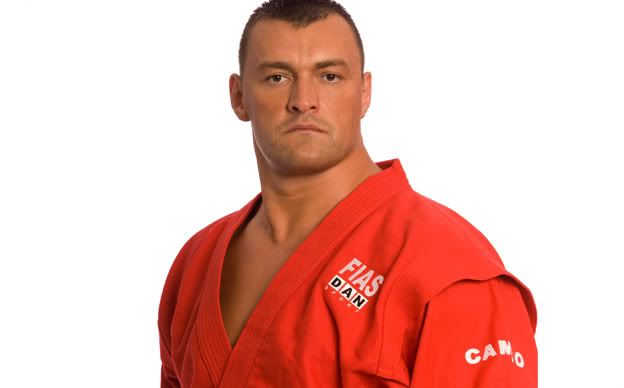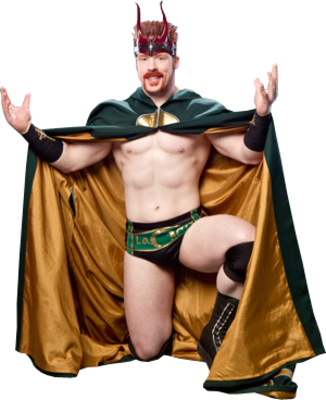wrestling / Columns
The Contentious Ten 04.25.11: Perfect Fits In Different Eras

You know when people wish they had been born in a different year, decade or even century? They feel misplaced, and often identify with the way-of-life or culture of a different time period. I wouldn’t say I’m one of those people, but I have watched many wrestlers and thought to myself, “this guy would have been a great fit in the 70s/80s/90s/00s.”
That isn’t to say the particular wrestler is doing- or was doing- a poor job of getting over in their own era, just that it would have been interesting to see the things they could have done elsewhere. This list looks at 10 such wrestlers. And so, The Top Ten Perfect Fits in Different Eras…
Brian Pillman size=6>

Perfect Fit: Late 1990s- Early 2000ssize=4>
The only reason this man doesn’t rank any higher on my list is the fact that he was so close to the “perfect fit” time period. It’s a shame too, because that makes it all the more unfortunate we were never able to see him reach his full potential in the Attitude Era, as his career ended just as the era was really getting off the ground. The “Loose Cannon” gimmick was edgy and controversial during a time when wrestling was campy and cartoony. It was just the kind of character that was resonating with the public during the height of wrestling’s popularity, just a few short years later. He knew what would work; he knew where wrestling was headed. How great would the promo exchanges between Brian Pillman and The Rock have been? Pillman and Triple H? Even Pillman and the New Age Outlaws. When you think about it, Pillman was always ahead of his time- even as far back as his WCW Flyin’ Brian days. Not only was his wrestling style unique, but also daring in the sense that it went against what was accepted as “main event” material.
Vladimir Kozlov size=6>

Perfect Fit: 1970s- 1980ssize=4>
What’s the reason a supposed badass foreigner like Vladimir Kozlov is in a comedy tag team with Santino Marella? It’s not because he sucks in the ring- guys at his level of ability have succeeded as singles wrestlers. It’s not because he rarely speaks- guys have gotten over on their own in the past with fewer words. It’s because in this day and age, a foreign monster heel feels outdated. Kozlov had a hard task in getting over with such a character, and it didn’t work. He dominated guys like Triple H and Jeff Hardy and was even given a win over Undertaker. It didn’t make a difference- he was placed in a completely wrong time. Put him in the 70s and 80s with guys like Ivan and Nikita Koloff; give him the same high profile wins he got in 2008, only against guys like Dusty Rhodes and Magnum T.A. Put him in that time and place, and Kozlov’s story might read very differently.
Bully Ray size=6>

Perfect Fit: 1980ssize=4>
Bully Ray is a natural heel. He’s the know-it-all douchebag at a bar; the aggravating bully in high school; the drunken prick at a club. He embodies the gimmick, and is easily one of the most compelling characters in TNA right now. However, he will always be remembered as a tag team guy. I’m not going to speak for anybody, but I think it’s safe to say that most wrestlers breaking into the business have aspirations of making it big as a singles star. That’s the ultimate desire- the ultimate goal- in the wrestling business. I truly believe Ray could have achieved that goal. The Bully Ray character works in basically any era, but I think he would have found the most success in the 80s. Everything he does is classic “bad guy,” and it fits in perfectly with the super hero babyfaces of the 80s. So, while I won’t question his success, he could have been a much bigger deal.
Ricky Steamboat size=6>

Perfect Fit: Present Daysize=4>
We go from a natural heel in Bully Ray to a natural babyface in Ricky Steamboat. Natural babyfaces are hard to come by, and we don’t have very many in wrestling right now. Think about it- John Cena (even he is questionable) and Rey Mysterio are really the only two that come to mind off my top of my head. I think the reason for that is it’s much easier to get people to hate you, than it is to get people to love you. Steamboat was easy to get behind. It wasn’t forced on you, it didn’t feel inorganic. Steamboat was a natural babyface, and could stand to benefit in today’s wrestling landscape. With so many heels and tweeners today, we could use a true babyface in the mix. Someone casual and hardcore fans alike can invest in emotionally. And there lies what is really missing from wrestling today- the investment. We don’t seem to care week-to-week as much as we used to. A babyface like Steamboat could go a long way in fixing that.
Mr. Anderson size=6>

Perfect Fit: Late 1990s- Early 2000ssize=4>
Mr. Anderson is one of the more obvious picks for this list. His character is cut right out of the Attitude Era, and that probably has a lot to do with Vince Russo’s fascination with recreating that time period. Despite the reasons, it’s the truth. He is a brash, arrogant, rebellious asshole that is cheered no matter how heelish his antics may be. That said, it would have been interesting to see how the crowd would have reacted to him alongside Steve Austin, a man who shared a similar gimmick. Either way though, heel or face, Anderson would have thrived in that environment. It doesn’t hurt to have a recognizable, fun catchphrase to be remembered by. It’s even a fantastic setup for The Rock’s “it doesn’t matter what your name is” bit. Additionally, his inclusion in this time period doesn’t have to be relegated to the WWF. I’ll bet he could have found a comfortable place in or against the nWo (probably both considering the way it was booked) as well.
Adam Pearce size=6>
.jpg)
Perfect Fit: 1970s- 1980ssize=4>
Everything about Adam Pearce is old-school. From his wrestling style and promo delivery to his ring gear and moveset, he screams of a much earlier time in professional wrestling. Unfortunately for Pearce, he competes in an indy scene that is dominated by guys trying to get over on visually impressive spots and flashy offense. So, while his toned-down, grinding offense sets him apart from the rest, it has gained him a good amount of criticism in the process- criticism of being a “boring” wrestler. Nevertheless, it’s almost as if he wants it that way, and that’s certainly awesome. Even still, it’s hard not to picture Pearce back in the 70s and 80s. He has made a career of incorporating that time period into his work, and it would be interesting to see him go against the originators of his style.
Randy Orton size=6>

Perfect Fit: 1980ssize=4>
Randy Orton is another guy I could see fitting in perfectly in the 80s. His wrestling style is more slow-paced and methodical than we’re used to seeing today, but it would easily match and play off of what others were doing back then. Before his fan-dictated babyface run, he was a true heel; a cold-blooded heel with no remorse. By his misguided reasoning, he believed all of his actions were justified. Everything about his character was classic heel, and it makes sense given Orton’s heritage. He studied and learned from the best, and was able to craft a believable character that people would be willing to pay money to see get beat up. A character like that would be a treat to watch interact with babyfaces such as Hulk Hogan, Jimmy Snuka and Dusty Rhodes and even heels like Roddy Piper or Jake Roberts.
“Superstar” Billy Graham size=6>

Perfect Fit: 1990s- 2000ssize=4>
There’s a reason his compilation DVD was titled, “20 Years Too Soon.” Many, from Scott Steiner to Hulk Hogan, credit Billy Graham for their look and persona. He, among a small select group of others, is responsible for the characters and personalities we have seen in the past and continue to see today. He had the tie-dyed gear, the bleached blonde hair and the body builder’s physique. He didn’t conform to what others were settling for, and opted to be different. While there was certainly a risk involved in that, he made it cool and acceptable. It was that kind of attitude that translated into the edgy, shades of grey heels that became popular in the 90s and into the 2000s. It’s also the kind of attitude that would have easily gotten him over during a time period where the cool bad guy was the character being cheered and selling merchandise. After all, it was the type of character he set the stage for in the 70s.
Sheamus size=6>

Perfect Fit: Early-Mid 1990ssize=4>
Sheamus is the character that initially brought the idea for this list to my mind. Since his arrival, I just can’t help but picture him as one of those cartoony superstars from the early to mid 90s- especially when he went around as King Sheamus for those few short months. If I had to pin-point it, I’d attribute that feeling to his overall look. From the characteristic red hair to the pale white skin, it’s all very comic book character-like and stands out from the more ordinary-looking superstars. Add to that the accent, nickname and theme music, and it’s quite an over-the-top gimmick, almost stereotypical. So much so, that he almost seems out of place amongst guys like John Cena, Randy Orton and The Miz. However, put him with other over-the-top (and in some cases, stereotypical) characters like Razor Ramon, Randy Savage and Ultimate Warrior, and it just works. I think the 90s would have been that much more fun with the angry Irishman Sheamus running around.
Gorgeous George size=6>

Perfect Fit: 1980s-1990ssize=4>
Gorgeous George- a character often overlooked, but just as influential as Billy Graham, if not more so. He had ring music when no one else had ring music; he had character-enhancing props; he had robes; he had the attitude. George is often credited with being one of the first wrestlers to develop a personality or gimmick. He didn’t confine himself to being just another “wrestler.” He wanted to find other ways to entertain, outside of putting on a pure wrestling match. In that way, his mindset was very much like that of present-day WWE. Really, it’s because of him that wrestling was able to find a home on television and grow an audience. He tapped into something that people wanted to see, and made it acceptable. He, more than most, was a true pioneer of professional wrestling. For everything mentioned above, he would have found a welcoming home in the 80s and 90s where characters such as his were the reason people were selling out arenas all across the country.
More Trending Stories
- Jade Cargill and Bianca Belair Comment On The Importance of Representation, Being Role Models For Girls
- Backstage Notes on This Week’s WWE NXT Talent Releases, When WWE Decided to Cut Drew Gulak
- WWE Releases NXT Talents Valentina Feroz, Boa, Trey Bearhill, More
- Michael Cole Reportedly Stepping Back From Backstage WWE Role, Will Remain As A Talent







